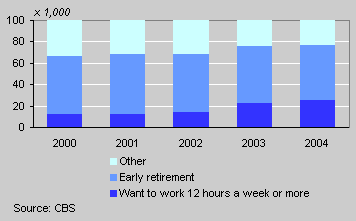One quarter of over-50s who left the job market seek to re-enter

In 2004 a total of 124 thousand men and women over the age of 50 chose to move out of a paid job. Over half of them quit their job permanently and entered (early) retirement, one quarter sought to re-enter the job market.
Half of over-50s left the work force permanently
In 2004 some 124 thousand persons in the 50–64 age bracket moved out of a paid job of 12 hours a week or more. The persons who left the work force constituted approximately 8 percent of employed over-50s.
Half of them quit their job permanently to enter (early) retirement. One quarter would like to have a (part-time) paid job and the remaining quarter were not looking for a job on account of poor health, labour disability or for other reasons.
Number of 50-overs moving out of the employed labour force

Rising proportion want to re-enter the job market
In 2004 one quarter of older people who left the work force wanted to re-enter, whereas in 2000 this was only 12 percent. The increase reflects the rise in unemployment during the period 2000-2004. The number of unemployed in the 50 - 64 age bracket in fact doubled in this period. The proportion of (early) retirement pensioners remained virtually stable.
Half of 50 to54 year-olds want to work again
Nearly half of 50 to 54 year-old early retired would like to work again for at least twelve hours a week. The rate for 55 to 59 year-olds is one in five and for 60-overs one in twenty.
Average age at (early) retirement 62 years
The average age of men who moved out of the work force is 60, women are on average two years younger. The average age of men and women who enter (early) retirement, on the other hand, is more or less the same. The average age at retirement is 62 for both genders.
Age men and women when leaving the labour market, 2000/2004

Henk-Jan Dirven and Clemens Siermann
Source: Sociaal-economische trends, 2005-III, p.32-36